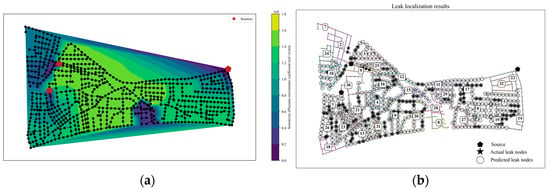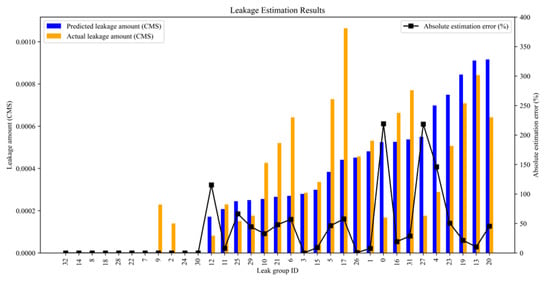Abstract
Leakage is a major issue faced by utilities across the world. Background leaks constitute a large component, and their small size makes it challenging to localize. This paper presents a hydraulic model-based approach to localize background leaks. The proposed methodology clusters nodes into leak groups using node-weighted spectral clustering and estimates background leakage in each leak group using optimization. The algorithm successfully localized 113 out of 118 background leaks (no leak size >0.28% of the bulk supply) and estimated the leakage amount using simulated data.
1. Introduction
Leak management is a major issue faced by water utilities across the world with water loss of up to 35% in developed [1] and more than 50% in developing nations [2]. Background leaks contribute to the major portion of these leaks and because of their small size, repairing them would be uneconomical. Hence pressure management can be considered an economical option for addressing background leaks [2] which requires an understanding of spatial distribution of leakage in the water distribution network (WDN). Since the background leaks and a single leak of the same leakage amount have different impacts on the pressure sensors due to the distribution of energy loss, this makes it much more challenging to localize background leaks. In the literature, numerous model-based and data-driven approaches were proposed by researchers focusing on leak localization using flow and pressure data [3,4]. But most of the methods in the literature, if not all, focus on large leaks or bursts, and background leakage has received limited attention. This paper presents a model-based approach for the localization and estimation of background leakage that uses on-field flow and pressure data.
2. Methodology
The framework of the proposed methodology is shown in Figure 1.

Figure 1.
The framework of the proposed methodology.
2.1. Sensitivity Analysis
Sensitivity analysis is carried out to understand the sensitivity of nodal pressures to leaks in the WDN. For this, leaks ranging between 0.1 and 2% of bulk supply are simulated as pressure-dependent demands using emitters as shown in Equation (1)
In Equation (1), , , are the leakage simulated, emitter coefficient and pressure at node ‘i’, respectively. The value of emitter exponent ‘n’ is fixed as 1 [5] since background leaks are not necessarily circular. Leaks of varying sizes are simulated at nodes for computing pressure sensitivity for the unit emitter coefficient using Equation (2) with ’no-leak’ scenario pressures as reference.
In Equation (2), and are the pressure change and emitter coefficient of node ‘n’, respectively. The sum of all columns in results in a column matrix, where each row represents the sensitivity of a node for that scenario [6]. The sensitivity matrix is constructed for different values of the emitter coefficient at each node, and the mean sensitivity for all scenarios is calculated and used as nodal weights for node-weighted spectral clustering in the later stage.
2.2. Clustering of Nodes
The clustering is performed to group all nodes into leak groups. The similarity of nodes is calculated using the calculated pressure sensitivity and connectivity of nodes [7] as shown in Equation (3) for clustering.
In Equation (3), is the similarity between nodes ‘i’ and ‘j’; is the weight of node ‘i’, i.e., pressure sensitivity; is the number of pipes incident at node ‘i’. is 0 if nodes ‘i’ and ‘j’ are not connected and is 1 otherwise. Spectral clustering is performed using the Python package sci-kit-learn [8] to cluster nodes using the nodal similarities as inputs. The number of leak groups is fixed as the number of pressure sensors installed in the WDN.
2.3. Leak Localization and Estimation
For leak localization, an optimization problem (Equation (4)) is solved with the emitter coefficient of each leak group as a decision variable, i.e., if there are leaks in a leak group that create a detectable pressure drop, the algorithm predicts all nodes in the leak group as leaky. A genetic algorithm is deployed to solve the optimization problem.
In Equation (4), and are the measured and simulated pressures of node ‘i’, respectively; and are the measured and simulated flows in pipe ‘j’, respectively.
3. Case Study and Dataset
The proposed methodology is demonstrated on a renowned L-town network with 33 pressure sensors (Figure 2) [9]. For the leak dataset, 7.5% of the pipes are assumed to be leaky, and leaks are simulated using emitters at both the start and end nodes of the selected pipes. The emitter is fixed so that no leak is bigger than 0.3% of the bulk supply (Figure 2).

Figure 2.
(a) L-town network; (b) simulated background leaks.
4. Results
The contour map of nodal sensitivity values, clustering, and leak localization results are shown in Figure 3. To partially account for inaccuracies in the hydraulic model, the demands in the model are perturbed by 10% before use for leak localization. Nodes associated with different leak groups are represented by distinct colors in the corresponding Figure 3, with each leak group labeled at the top of its respective cluster.

Figure 3.
(a) Sensitivity analysis results; (b) clustering and leak localization.
As shown in Figure 3, 113 out of the 118 leaks simulated are localized to their respective leak groups. Figure 4 shows the leak estimation error for each leak group.

Figure 4.
Leak estimation error.
In the majority of leak groups, the error estimate is between 2 and 50% of simulated leakage. But for groups 4, 27, and 0, leakage is overestimated due to neighboring high-leakage groups causing increased pressure drops, a drawback of the methodology. Despite higher errors in a few groups, the proposed methodology performed well for the majority of the leak groups and hence benefits water utilities and our understanding of spatial leakage distribution, aiding in supply and leakage management decisions.
5. Conclusions
A sensitivity analysis-based node-weighted spectral-clustering method is proposed for localizing leaks and estimating background leaks in water distribution networks. The approach clusters WDN nodes into leak groups and identifies leakage within each group by minimizing differences between simulated and observed flow/pressures. As demonstrated on the L-town network using simulated data, the algorithm successfully localized 113 out of the 118 leaks ranging from 0.14% to 0.28% of the bulk supply, aiding water utilities in improved decision-making for WDN operation and leakage management.
Author Contributions
Conceptualization, R.B., and R.F.; methodology, R.B., and R.F.; formal analysis, R.B.; investigation, R.B.; resources, R.B.; writing—original draft preparation, R.B.; writing—review and editing; R.F. visualization, R.B.; supervision, R.F. All authors have read and agreed to the published version of the manuscript.
Funding
This research was funded by EPSRC DTP (Project reference: 2696644).
Institutional Review Board Statement
Not applicable.
Informed Consent Statement
Not applicable.
Data Availability Statement
The original data presented in this study are openly available in [9].
Conflicts of Interest
The authors declare no conflicts of interest.
References
- Levinas, D.; Perelman, G.; Ostfeld, A. Water leak localization using high-resolution pressure sensors. Water 2021, 13, 591. [Google Scholar] [CrossRef]
- Rajakumar, A.G.; Cornelio, A.A.; Mohan Kumar, M.S. Leak management in district metered areas with internal pressure reducing valves. Urban Water J. 2020, 17, 714–722. [Google Scholar] [CrossRef]
- Wan, X.; Kuhanestani, P.K.; Farmani, R.; Keedwell, E. Literature review of data analytics for leak detection in water distribution networks: A focus on pressure and flow smart sensors. J. Water Resour. Plan. Manag. 2022, 148, 03122002. [Google Scholar] [CrossRef]
- Romero-Ben, L.; Alves, D.; Blesa, J.; Cembrano, G.; Puig, V.; Duviella, E. Leak detection and localization in water distribution networks: Review and perspective. Annu. Rev. Control 2023, 55, 392–419. [Google Scholar] [CrossRef]
- Greyvenstein, B.; Van Zyl, J.E. An experimental investigation into the pressure-leakage relationship of some failed water pipes. J. Water Supply Res. Technol.—AQUA 2007, 56, 117–124. [Google Scholar] [CrossRef]
- Morosini, A.F.; Costanzo, F.; Veltri, P.; Savić, D. Identification of measurement points for calibration of water distribution network models. Procedia Eng. 2014, 89, 693–701. [Google Scholar] [CrossRef]
- Fang, Q.; Zhao, H.; Xie, C.; Chen, T. A method for water supply network DMA partitioning planning based on improved spectral clustering. Water Supply 2023, 23, 3432–3452. [Google Scholar] [CrossRef]
- Pedregosa, F.; Varoquaux, G.; Gramfort, A.; Michel, V.; Thirion, B.; Grisel, O.; Duchesnay, É. Scikit-learn: Machine learning in Python. J. Mach. Learn. Res. 2011, 12, 2825–2830. [Google Scholar]
- Vrachimis, S.G.; Kyriakou, M.S. LeakDB: A benchmark dataset for leakage diagnosis in water distribution networks. WDSA/CCWI Jt. Conf. Proc. 2018, 1, 146–153. [Google Scholar]
Disclaimer/Publisher’s Note: The statements, opinions and data contained in all publications are solely those of the individual author(s) and contributor(s) and not of MDPI and/or the editor(s). MDPI and/or the editor(s) disclaim responsibility for any injury to people or property resulting from any ideas, methods, instructions or products referred to in the content. |
© 2024 by the authors. Licensee MDPI, Basel, Switzerland. This article is an open access article distributed under the terms and conditions of the Creative Commons Attribution (CC BY) license (https://creativecommons.org/licenses/by/4.0/).